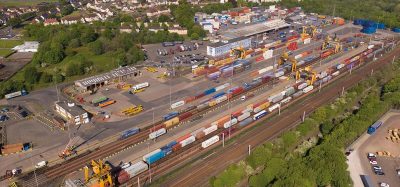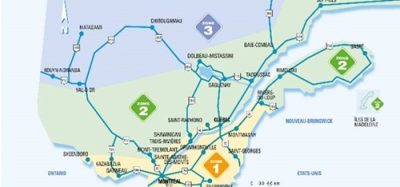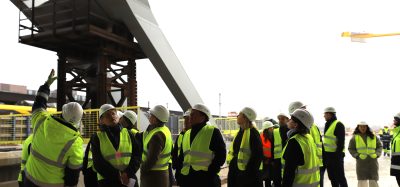Freight operation growth ensures economical potential
Posted: 8 April 2008 | | No comments yet
The strategic focus of DB Schenker is on the creation of end-to-end service offers on the European rail corridors. While the North-South connections have been operating without problems, we have been quite engaged for some time in efforts along the East-West corridor. The acquisitions of EWS, a British rail freight transport company and its French subsidiary, ECR, as well as Transfesa, a Spanish rail freight forwarder, cover the most important European markets. At the same time, we are working very hard on linking them to the East.
The strategic focus of DB Schenker is on the creation of end-to-end service offers on the European rail corridors. While the North-South connections have been operating without problems, we have been quite engaged for some time in efforts along the East-West corridor. The acquisitions of EWS, a British rail freight transport company and its French subsidiary, ECR, as well as Transfesa, a Spanish rail freight forwarder, cover the most important European markets. At the same time, we are working very hard on linking them to the East.
The strategic focus of DB Schenker is on the creation of end-to-end service offers on the European rail corridors. While the North-South connections have been operating without problems, we have been quite engaged for some time in efforts along the East-West corridor. The acquisitions of EWS, a British rail freight transport company and its French subsidiary, ECR, as well as Transfesa, a Spanish rail freight forwarder, cover the most important European markets. At the same time, we are working very hard on linking them to the East.
Freight transports between Germany and Russia are known for their long waiting times at border crossings, bad roads, time-consuming rail gauge changes for rail transports, and occasionally overloaded seaports. Since 18 October 2007, the new railway ferry line between Sassnitz/Mukran and Baltiysk (previously known as Pillau), a seaport within the Kaliningrad enclave, has opened up a fast alternative via the Baltic Sea. Goods can already be loaded onto broad gauge freight cars in the Sassnitz/Mukran seaport for non-stop transportation to Russia. Along with the weekly “RailBridge”, DB Schenker is also offering innovative solutions for simplifying trade between both countries.
Trade between Germany and Russia is booming: annual growth rates for both imports and exports exceed 30%. Germany is Russia’s most important supplier, while last year 13.4% of Germany’s imports came from Russia.
In order to increase the market share held by rail, DB founded a joint venture this year with RZD Russian Railways and the rail freight arms of the Polish railways PKP and Belarusian railways BC. The purpose of the new production company is to cut transport time along the Berlin – Moscow corridor from ten to three days. The Baltic Sea route already offers similarly fast shipping times with the railway ferry covering the distance between the German and the Russian seaports in 16 hours. The Sassnitz/ Mukran seaport was predestined to become the starting point because it had previously served as the hub for transports to and from the former Soviet Union during the East German era. In addition, Sassnitz/Mukran also has the infrastructure facilities needed to handle goods transported by Russian broad gauge freight cars.
Innovation fostered by tradition
In view of the increased transport volumes, Deutsche Bahn, the owner of the Mukran rail station covering 340 hectares, is upgrading its Rügen location to become a modern distribution centre. Direct transshipment of goods onto broad gauge freight cars via loading or gauge conversion shortens the waiting time for customers and the shipping time for the goods.
DB Schenker can offer its customers good conditions on the direct route to Russia because it cooperates closely with DFDS, a shipping line, and RZD, the Russian national railway. The Rail/Ro/Pax ship Vilnius is equipped to handle all categories of rolling transports – ranging from rail freight cars, trucks and trailers to special vehicles as well as out-of-gauge loads. Baltiysk offers excellent rail connections to the Moscow metropolitan area. Furthermore, less expensive Russian rail freight tariffs apply from Baltiysk onwards.
Difficulties in trade with Russia are not only limited to uncertain transit times and security problems arising during handling. The lack of coordinated legal conditions, such as customs clearance formalities and freight carriage laws, make work even harder for freight forwarders and shippers. Procedures for transit transports, in particular, are especially complex. Thanks to the start-up of operations in the Russian enclave of Kaliningrad, customers can now benefit from a uniform CIM bill of lading on the shortest possible sea route to Russia. Customers can complete Russian customs clearance procedures directly in Baltiysk. Another important aspect, in particular, is access to covered Russian broad gauge freight cars. Because the Sassnitz/Mukran – Baltiysk line has been heavily supported by business and political interests, it is provided with rail freight cars on a preferential basis, which prevents any bottlenecks from occurring, even during peak times.
The availability of rail freight cars is a critical factor for shipping goods within and to Russia. Rail holds an 80% share of the market and remains the dominant mode of transportation within Russia.
Environmentally-friendly market opening
Another positive reason for transporting goods via the shared modes of rail and short sea is that this route results in a far lower burden on the environment in comparison to other modes of transport. The partial shift of rail transports to short sea transport is exactly in line with the goals of the Kyoto Protocol.
The good capacity utilisation rate achieved by the new rail ferry line within a short time after it began operations shows that many customers have recognised the benefits of shipping their goods, especially building materials, paper and cellulose, as well as food products, via the Sassnitz/Mukran-Baltiysk Railbridge. Automobile transports are also gaining importance and a modern, high-performance automobile terminal is available in Baltiysk for this purpose. DB Schenker is working to further expand the transport connection together with DFDS Lisco, the two seaports and Russian partners. The goal is to increase the ferry service frequency and to extend the ferry line service to Ust-Luga, near St. Petersburg, in the future.
Beijing-Hamburg Container Express: 10,000km in only 15 days1
In January 2008, after just 15 days journey time, a freight train from Beijing loaded with containers reached the marshaling yard in the Port of Hamburg. The Beijing-Hamburg Container Express left Dahongmen Station in the Chinese capital on 9 January 2008 for the journey of over 10,000km through China, the Mongolian Republic, Russia, Belarus, Poland and Germany. Hartmut Mehdorn, Chairman of the Board of Management of Deutsche Bahn AG, stated on the train’s arrival, “The excellent cooperation between the railroad employees of the six participating companies is impressive proof that Asian-European freight transport along the Eurasian Land Bridge has a future. If we can overcome further technical and bureaucratic hurdles and upgrade the infrastructure, and if the demand for transport services from Europe to Asia also grows, by the end of the decade we can aim at launching regular freight transport services along this axis.”
Mehdorn’s colleagues, and in particular Vladimir Yakunin, President of OAO Russian Railways, underlined the strategic importance of an efficient rail connection given the continued growth in flows of goods between Europe and Asia. The participants in the Eurasian Land Bridge project are the railroads of the six countries along the route. The goal is to strengthen rail’s competitive position in relation to ocean transport. Seagoing vessels require more than 30 days for the ocean route.
“The test train was a success. We have demonstrated that we can transport goods by rail between China and Germany safely, reliably and yet twice as fast compared with ships. At the same time, we’re considerably cheaper than air freight for many types of cargo. Now is the time to analyse and compare our notes with all partners and to define the next steps”, stated Dr. Norbert Bensel, Member of the Board of Management for Transportation and Logistics at DB AG.
Rail freight transport seen as fast alternative to ocean freight2
Rapid growth and major economic potential are the two key characteristics of the Asian transportation and logistics market, and especially to the Chinese market. Deutsche Bahn AG has positioned itself to benefit from these developments as well as from the rising global flow of goods. The company intends to further expand its global transportation and logistics networks towards China to enable its customers to participate in the rapidly growing exchange of goods with the People’s Republic of China. In addition, the fast growing domestic freight transport sector in China offers potential that DB AG intends to focus on in the coming years. This is why signals are being set eastwards for DB AG – because a company will only be able to remain competitive in the market over the long run if it can offer its customers tailor-made, multi-modal transport service across all borders.
Deutsche Bahn AG ready to roll in the growing Asian market
DB AG is currently the world’s number two provider of transportation and logistics services and an important partner to the export sector in Germany and Europe. In the interim, logistics has become the third most important branch of business in the Federal Republic of Germany and is continuing to grow at a dynamic pace. DB AG has forecast growth rates of up to eight percent per year through to 2011, for example in the worldwide ocean freight segment and also in the contract logistics business.
Logistics markets like Russia and China are developing rapidly and are currently still very fragmented. In these markets long-term relationships, market access via proprietary networks and local presence are of decisive importance in developing and participating in the growth and consolidation of the local sector. DB AG has an excellent starting position in the European-Asian sector. Shencker AG, for example, has already been in some of the local markets for decades. Furthermore, DB AG has maintained good relationships with the railways operating in the region.
The Chinese transportation and logistics market
Asia will also retain its role as an economic locomotive in the coming years with China playing a decisive role as its economy is anticipated to grow by about eleven percent. China’s trade surplus of 262 billion dollars in 2007 means that it is well on its way to replacing Germany as the world’s number one exporter; concurrently domestic demand will also expand strongly in the Middle Kingdom.
Based on European Commission statistics, exports from the EU to China rose by approximately 11% in 2006, while the EU’s share of imports from China increased by approximately 19%.
The growing volume of trade between the continents requires fast and reliable transport links. For this reason Deutsche Bahn AG is increasingly focusing on routes to China via the Eurasian Land Bridge. This is reflected by the company’s plans to push expansion of freight routes along the 10,000km-long Moscow-China corridor in collaboration with partner railways.
DG AG is certain of the major potential of the Eurasian Land Bridge as it offers shippers considerably shorter transport time in comparison to ocean freight, and lower costs vis-à-vis airfreight. While goods take up to 40 days to travel between Germany to China via ship, the journey to China via train would only take about 15 days.
Improving cost structures
In comparison to ocean freight, rail transport is burdened by price disadvantages caused by additional costs for positioning and leasing containers as well as by running costs for empty freight cars. The participating railways are currently working very closely together to develop initial solutions towards reducing these and related costs. The key lever to lower costs is regularly scheduled, container circuits running with equal loads of goods, thereby reducing expensive empty car runs. To help achieve this goal the existing flows of goods being transported eastwards to Russia and Central Asia should be integrated into the plan. In addition, long term, stable rail freight tariffs will lead to a further reduction in costs.
Improving overall conditions
The participating countries and their railways want to streamline border clearance procedures. Customs clearance and handling processes at the various borders should be significantly simplified. The railway companies want to standardize the different freight transport formalities by using one set of approved documentation for the entire trip as well as by introducing an electronic exchange of information. These proposals would eliminate unnecessary interface points with high potential for error. At the same time the various customs clearance processes should be accelerated by simplifying customs requirements.
In addition to improving procedures at the borders the railways are focused on providing customers fast offers and a complete chain of shipping information. The improvement of reloading capacities at the borders involves potential capital expenditures and significant investments have already been planned to expand the capacities of the re-gauging facilities at the Chinese-Russian border.
References
1, 2. www.db.de/presse






